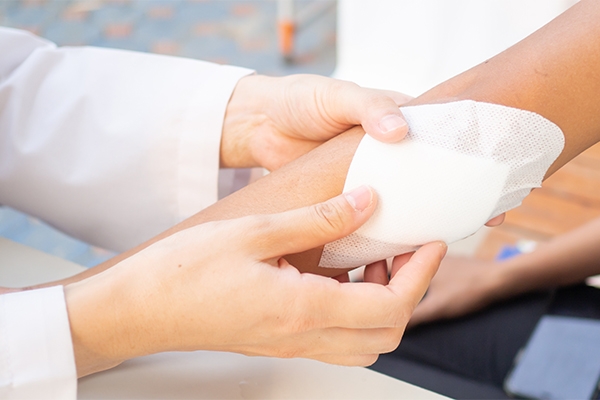Healing Diabetic Wounds: Is It Possible?

A wound is one of the most common indications of diabetes. In persons with normal blood sugar levels, wounds heal and dry quickly. People with diabetes, on the other hand, experience the opposite. Wounds take longer to heal and can worsen rapidly.
Diabetes develops when the body's ability to produce or use insulin, a hormone that plays a role in converting glucose or sugar into energy. The body's difficulty metabolizing glucose results in high blood sugar levels, making it unable to heal wounds quickly.
Wounds can develop anywhere on the body, whether scratches, cuts, or blisters. Generally, wounds improve or heal within two weeks. However, in people with diabetes, wounds can last longer, triggering other health issues.
Wounds are commonly found on the feet. If not treated immediately, foot wounds can become serious— even around 15% of people with diabetes experience foot ulceration. Therefore, knowing and treating wounds is vital to avoid infection and complications.
Why are wounds difficult to heal?

When you have diabetes, many things cause wounds to be challenging to heal, not heal completely, or unable to heal. This condition happens because people with diabetes suffer from different diseases, such as:
High blood sugar levels
High blood sugar levels prevent nutrients and oxygen from energizing cells. They also cause inflammation in body cells, which makes wounds heal more slowly.
Nerve function
High blood sugar levels can damage nerve function and usually affect the hands, legs, and feet. About 60% of people with diabetes experience this. Worsening nerve function will have a severe impact on wounds and healing.
The main issue with this condition is that people with diabetes are unaware that they have wounds because they do not feel pain. Finally, the wound became infected and got worse because it didn't get immediate treatment.
Poor circulation
Poor circulation causes wounds to heal more slowly. This condition is because blood has a more challenging time reaching the wound site, even though blood functions to fight infection and help heal wounds.
People with diabetes have an increased chance of developing peripheral vascular disease. The narrowing of the blood vessels reduces blood flow to the limbs. Higher blood glucose levels increase blood viscosity, further impacting blood flow.
Weakened immune system
High blood sugar levels can change blood chemistry, reducing the body's defenses and slowing down the immune system. People with diabetes have a weakened immune system, which causes poor wound healing and increases the risk of infection.
Untreated infections that spread might result in problems like gangrene or sepsis.
What if you've already had a wound?
The following tips can help wound healing:
Conduct regular self-examinations
Detecting wounds early is the most effective method of reducing infection and complications. Conduct frequent self-examinations and look for new wounds, especially on your feet. Remember to inspect between and under your toes.
Remove the dead tissue
Necrosis (dead cells) is common in diabetic wounds. This can encourage the growth of bacteria and toxins, leading to a rise in wound infection. It can also prevent you from examining the underlying tissue. Visit a doctor. Usually, the doctor will assist with the removal of dead tissue.
Keep the wound dressing dry and clean
Changing the dressing can reduce and minimize bacterial growth and moisten the area. Use a specialized dressing for wound management.
Try not to apply pressure on the wound area. Pressure can harm the skin and result in deeper wounds or ulcers.
So, what are the indicators that diabetic wounds are not being appropriately treated? Diabetic wounds that are not being treated properly have the following characteristics:
1. The inflammation lasts too long or heals but then returns
Inflammation is expected during the healing process. However, after about a week, the redness and swelling around the wound should lessen. If conditions don't, something is preventing healing. It could be an infection or another problem.
2. Infection or tissue damage occurs
Diabetic wounds cannot heal if infected. Consult a doctor if your wound or the skin around it:
- Feels tender, painful, or heated to the touch
- Draining pus or fluids
- Dark in color around the edges
- Emitting an unpleasant odor
3. Wounds that don’t heal for more than four weeks
A chronic wound does not heal completely within a month. While chronic wounds can heal independently, seeking medical attention is best to determine why they aren't healing.
How to keep wounds from worsening

The most important thing you can do to keep minor wounds from becoming serious is to identify and treat them as soon as possible. However, various options can help in wound healing, such as
1. Consuming high-protein and healthy foods
People with diabetes should eat less carbohydrates and more protein. Eating low-sugar and low-glycemic foods is a simple way to stabilize blood sugar.
Meanwhile, eating more protein can aid in wound healing. Consuming more protein also promotes new tissue growth in wounds, allowing them to heal faster.
Fiber-rich food, such as fruits, vegetables, and nuts, can increase wound healing and immunity.
2. Exercise
Regular exercise increases insulin sensitivity. This activity allows sugar in the bloodstream to reach cells more efficiently, promoting healing and wellness.
3. Quit smoking
Smoking reduces the ability of cells to carry oxygen. Smoking also impairs the immune system and raises the risk of blood vessel disease.
4. Routine check-ups with your doctor
If you already have diabetes, remember to take your medicine and have frequent check-ups with your doctor according to the schedule, especially if your body has existing wounds.
If you need diabetic wound care or have diabetes-related questions, visit the GWS Medika Clinic, a health clinic in Jakarta.



